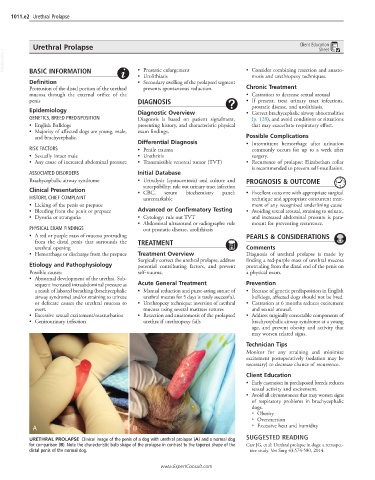Page 2021 - Cote clinical veterinary advisor dogs and cats 4th
P. 2021
1011.e2 Urethral Prolapse
Urethral Prolapse Client Education
Sheet
VetBooks.ir
• Prostatic enlargement
BASIC INFORMATION
• Urolithiasis • Consider combining resection and anasto-
mosis and urethropexy techniques.
Definition • Secondary swelling of the prolapsed segment
Protrusion of the distal portion of the urethral prevents spontaneous reduction. Chronic Treatment
mucosa through the external orifice of the • Castration to decrease sexual arousal
penis DIAGNOSIS • If present, treat urinary tract infections,
prostatic disease, and urolithiasis.
Epidemiology Diagnostic Overview • Correct brachycephalic airway abnormalities
GENETICS, BREED PREDISPOSITION Diagnosis is based on patient signalment, (p. 128), and avoid conditions or situations
• English Bulldogs presenting history, and characteristic physical that may exacerbate respiratory effort.
• Majority of affected dogs are young, male, exam findings.
and brachycephalic. Possible Complications
Differential Diagnosis • Intermittent hemorrhage after urination
RISK FACTORS • Penile trauma commonly occurs for up to a week after
• Sexually intact male • Urethritis surgery.
• Any cause of increased abdominal pressure • Transmissible venereal tumor (TVT) • Recurrence of prolapse: Elizabethan collar
is recommended to prevent self-mutilation.
ASSOCIATED DISORDERS Initial Database
Brachycephalic airway syndrome • Urinalysis (cystocentesis) and culture and PROGNOSIS & OUTCOME
susceptibility: rule out urinary tract infection
Clinical Presentation • CBC, serum biochemistry panel: • Excellent outcome with appropriate surgical
HISTORY, CHIEF COMPLAINT unremarkable technique and appropriate concurrent treat-
• Licking of the penis or prepuce ment of any recognized underlining cause
• Bleeding from the penis or prepuce Advanced or Confirmatory Testing • Avoiding sexual arousal, straining to urinate,
• Dysuria or stranguria • Cytology: rule out TVT and increased abdominal pressure is para-
• Abdominal ultrasound or radiographs: rule mount for preventing recurrence.
PHYSICAL EXAM FINDINGS out prostatic disease, urolithiasis
• A red or purple mass of mucosa protruding PEARLS & CONSIDERATIONS
from the distal penis that surrounds the TREATMENT
urethral opening Comments
• Hemorrhage or discharge from the prepuce Treatment Overview Diagnosis of urethral prolapse is made by
Surgically correct the urethral prolapse, address finding a red-purple mass of urethral mucosa
Etiology and Pathophysiology potential contributing factors, and prevent protruding from the distal end of the penis on
Possible causes: self-trauma. a physical exam.
• Abnormal development of the urethra. Sub-
sequent increased intraabdominal pressure as Acute General Treatment Prevention
a result of labored breathing (brachycephalic • Manual reduction and purse-string suture of • Because of genetic predisposition in English
airway syndrome) and/or straining to urinate urethral meatus for 5 days is rarely successful. bulldogs, affected dogs should not be bred.
or defecate causes the urethral mucosa to • Urethropexy technique: inversion of urethral • Castration at 6 months reduces excitement
evert. mucosa using several mattress sutures and sexual arousal.
• Excessive sexual excitement/masturbation • Resection and anastomosis of the prolapsed • Address surgically correctable components of
• Genitourinary infection urethra if urethropexy fails brachycephalic airway syndrome at a young
age, and prevent obesity and activity that
may worsen related signs.
Technician Tips
Monitor for any straining and minimize
excitement postoperatively (sedation may be
necessary) to decrease chance of recurrence.
Client Education
• Early castration in predisposed breeds reduces
sexual activity and excitement.
• Avoid all circumstances that may worsen signs
of respiratory problems in brachycephalic
dogs.
○ Obesity
○ Overexertion
A B ○ Excessive heat and humidity
URETHRAL PROLAPSE Clinical image of the penis of a dog with urethral prolapse (A) and a normal dog SUGGESTED READING
for comparison (B). Note the characteristic bulb shape of the prolapse in contrast to the tapered shape of the Carr JG, et al: Urethral prolapse in dogs: a retrospec-
distal penis of the normal dog. tive study. Vet Surg 43:574-580, 2014.
www.ExpertConsult.com

